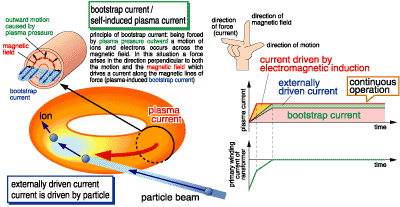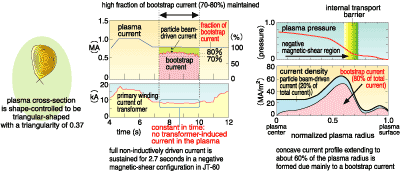As illustrated in Fig. 2-3 a "bootstrap current" arising spontaneously in a confined tokamak plasma is quite favorable for an efficient steady-state (continuous) operation of a tokamak reactor: the bootstrap plasma current is a DC current driven non-inductively, essential for steady-state tokamak operation. The radial profile of the bootstrap current is concave-shaped owing to the physics nature of its origin (Fig. 2-3), leading to the formation of a negative magnetic-shear region inside the plasma. We have already demonstrated on JT-60 that in the negative magnetic-shear region the plasma confinement is remarkably improved due to the formation of a thermal insulation layer (internal transport barrier, ITB) which hinders thermal and particle losses from the central plasma.
To realize a high performance steady-state tokamak operation, it is crucial to control the magnitude and the distribution of bootstrap current which are closely related to the behavior of plasma pressure, and the formation of an ITB together with its location in the plasma, and thus to sustain continuously a high fraction of bootstrap current. In recent experiments on JT-60, we have tried various approaches including shaping the plasma cross-section into a triangular-shape to improve plasma stability, feedback control of the plasma stored energy to maintain a high plasma pressure necessary for a high fraction of bootstrap current and its sustainment, ramp-up control of the plasma current to obtain an initially concave current profile etc. As a result we have successfully demonstrated a steady-state sustainment of a fully non-inductive plasma current consisting of 80% bootstrap current and 20% neutral beam-driven current for 2.7 seconds. The negative magnetic-shear region covered up to 60 - 70% of the plasma cross-sectional area, and consequently a plasma confinement performance as high as 3.6 times compared to the standard tokamak confinement was obtained (Fig. 2-4). This is progress towards the development of steady-state operation of a tokamak fusion reactor like ITER. |

